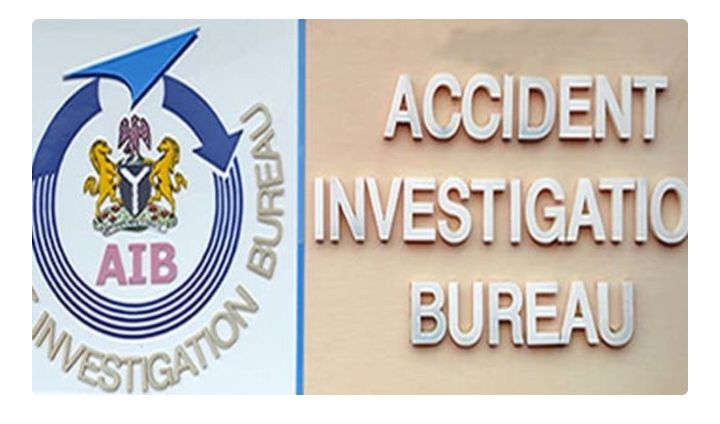Font size:
Print
AIB releases reports, AIB, AIB releases reports, Investigation Bureau Bill, , Safety Investigation Bureau
Nigeria’s Accident Investigation Bureau (AIB) has again made history by releasing eight aircraft accident reports to the public in a fell swoop.
The reports released, on Thursday, according to the Commissioner of the Bureau, Mr Akin Olateru, covered the period between 2010 and 2019.
Releasing the reports at the Bureau’s headquarters in Abuja, Olateru said out of the released reports, while was one was classified as an accident, the remaining seven were serious incidents.
Describing the released reports as the biggest haul since the establishment of the Bureau, the Commissioner said the Bureau was very conscious of its critical role in assuring aviation safety in the country and globally saying: “We will continue to pursue this with all vigour as we have the men and the equipment, backed with government support, to ensure that AIB-N plays its role effectively and purposefully.”
According to Olateru, the reports released were with a total of nine safety recommendations, which he said were addressed to the Regulatory body, the affected airlines and the Federal Airport Authority of Nigeria (FAAN) among others.
“There are international dimensions to two of the reports we are releasing today. There is a Turkish Airlines owned aircraft, which was involved in one of the occurrences, while the other occurrence involving Arik Air took place in Accra Ghana.”
The eight reports released include: the report on the Serious Incident involving a B737-500 aircraft operated by Air Peace Limited with nationality and registration marks 5N-BRN, which occurred at Port Harcourt Airport, Omagwa, Rivers State On June 22, 2019.
Report on the Serious Incident involving HS-125-700A aircraft operated by Associated Aviation Limited with nationality and registration marks 5N-BEX, which occurred at Benin Airport, Edo State, Nigeria on July 10, 2011 and the Serious Incident involving a B737-200 aircraft with nationality and registration marks 5N-BIF owned and operated by Chanchangi Airlines, which occurred at Kaduna Airport, Runway 05, Kaduna State, Nigeria on 20th of August, 2010.
Also released was. the Serious Incident involving a Bombardier DHC-8-Q400 aircraft owned and operated by Arik Air Nigeria Ltd with nationality and registration marks 5N-BKX which occurred en route Kotoka International Airport, Accra, Ghana on 6th March 2018 and the Serious Incident involving a Boeing 737- 500 aircraft operated by Med-View Airline with nationality and registration marks 5N-BQM, which occurred at FL320 en route Murtala Muhammed Airport, Lagos On 23rd July 2019.
The three other released reports involved the Accident involving a Hawker Siddeley HS-125-800 XP aircraft owned and operated by SWAT Technology Limited with nationality and registration marks N497AG, which occurred on Runway 21, Port-Harcourt Airport, Omagwa, Rivers State On 11th June 2015, the Serious Incident involving an Airbus 330-343 aircraft operated by Turkish Airlines Inc. with nationality and registration marks TC-LOL, which occurred at Port Harcourt Intl. Airport, Omagwa, Rivers State, Nigeria On 31st December 2019 and the Serious Incident involving Boeing 737- 300 aircraft owned and operated by Air Peace Limited with nationality and registration marks 5N-BUK which occurred at Murtala Muhammed Airport, Lagos on 15th May 2019.
The AIB Commissioner while running through four of the released reports, urged the public to check out the eight reports on the AIB website www.aib.gov.ng which he said had already been uploaded on the website for the public to see.
Speaking on the incident involving an Airbus 330-343 aircraft operated by Turkish Airlines which occurred at Port Harcourt International Airport, Omagwa, Rivers State, Nigeria on 31st December 2019, Olateru from the findings of the Bureau said the flight departed from Istanbul for Port Harcourt with 295 persons on board including eleven crew members.
“The Captain was the Pilot Flying (PF), while the Co-Pilot was the Pilot Monitoring (PM). At 03:10 h, THY3WJ established two-way contact with Port Harcourt Approach reported descending to FL220 on-course NAPVA1, and received weather information with relevant clearances.
“The aircraft touched down with its main landing gear at about 612 m from the threshold, right of the runway centreline, crossed the right-side runway strip marking onto the right runway shoulder, impacted and damaged three-runway edge lights, and returned to the runway at a distance of about 1,037 m from the threshold.
“The tyre marks further indicated that the aircraft returned to the runway centreline at about 1,478 m from the threshold. The approach was performed at night and the crew reported haze and patches of fog at a low level. The Port Harcourt International Airport runway was equipped with only edge lights with no centreline and runway touchdown zone lights.”
The investigation identified the causal factor of the accident to been the extra right aileron and rudder input by the Pilot Flying in the last 100 feet caused the aircraft to drift right of the runway centreline.
A contributory factor was traced to the inappropriate rudder application by the flight crew in the last 45 feet which did not prevent the right drift before touchdown but rather increased the drift at touchdown and the non-adherence to the provisions of the Standard Operating Procedures as contained in the Turkish Airlines Flight Crew Techniques Manual. One Safety Recommendation was made.
The Bureau in its recommendations advised Turkish Airlines to ensure flight crew adherence to provisions of the Standard Operating Procedures as contained in the Turkish Airlines Flight Crew Techniques Manual vis-à-vis landing techniques.
Report on the Accident involving a Hawker Siddeley HS-125-800 XP aircraft owned and operated by SWAT Technology Limited which occurred on Runway 21, Port-Harcourt Airport, Omagwa, Rivers State on 11th June 2015 and had five persons on board inclusive of three flight crew and two passengers, departed Nnamdi Azikiwe International Airport, Abuja at 18:25 h for Port Harcourt as a charter flight.
According to the findings, “At 18:55 h, the aircraft was released by Lagos to continue with Port Harcourt. Port Harcourt then cleared N497AG to descend FL210.
At 19:13 h, the crew reported field in sight at 6 nautical miles to touch down to the Tower Controller (TC). TC then cleared the aircraft to land, with caution “runway surface wet”. The crew experienced light rain at about 1.3 nautical miles to touch down with runway lights ON for the ILS approach.
“At 19:16 h, the aircraft touched down with the left main wheel in the grass and the right main wheel on the runway but was steered back onto the runway. The nose wheel landing gear collapsed, and the aircraft stopped on the runway.
The engines were shut down and all persons on board disembarked without any injury. The aircraft was substantially damaged.”
The causal factor identified by the accident investigators which led to a black hole effect disorientation causing low-level manoeuvre into grass verge contributed to most of the Runway 21 right edge lights becoming unserviceable at landing time and the inadequate Crew Resource Management during the approach.
Report on the Incident involving Chanchangi Airlines which occurred at Kaduna Airport, Runway 05, Kaduna State, Nigeria on 20th of August, 2010, showed the aircraft descended in stormy weather, struck and uprooted the Non-Directional Beacon (NDB) antenna 50 ft (15 m) high, some approach lights, and landed 240 meters short of the runway damaging three tyres: one on the nose wheel and one each on the main landing gear. The aircraft continued its movement into the runway, taxied to the ramp and parked. The three tyres were immediately replaced. This incident occurred at 20:41 h at night time.
While none of the flight crew and passengers sustained any injury, investigations identified the causal factor to be the loss of speed, altitude and situational awareness due to poor instruments’ scanning on short finals Runway 05 while the contributory factor was traced to the fact that the aeroplane was flown at a high descent rate (825 fpm) when the aircraft was just 225 ft above runway during approach and the possible increase in crew workload due to thunderstorm activities in the vicinity of the airport.
On the incident involving a Bombardier DHC-8-Q400 aircraft belonging to Arik Air which occurred en route to Kotoka International Airport, Accra, Ghana, AIB said it was not officially notified of the serious incident.
“The Bureau only became aware of the incident following a post on social media on March 8, 2018. The Bureau immediately contacted the Ghana Civil Aviation Authority (GCAA), being the state of occurrence for consultation and further clarification.
The Bureau’s Investigators were dispatched to the Air Force hangar within the Kotoka International Airport Accra, Ghana where the aircraft was parked and investigation commenced immediately. All relevant stakeholders were duly notified.”
“In his statement, which was corroborated by the cabin crew in their individual statements, the Captain stated that, at about 81 Nautical Miles to Accra VOR, smoke was observed in the mid-section of the cabin and seemed to be emanating from the right side air vents. The Captain immediately declared the emergency to the Approach unit (APP), requested priority landing and evacuation, and instructed the cabin crew to prepare the cabin for an emergency landing.
“The Captain stated that while executing the checklist “FUSELAGE FIRE, SMOKE or FUMES” in the aircraft Quick Reference Handbook (QRH), the smoke cleared before the localizer capture during the approach. ARA304 then informed Tower (TWR) that they would no longer evacuate passengers on the runway as initially planned as the smoke had cleared and therefore requested to exit the active runway on landing through taxiway “Y” to “E” bay. The aircraft landed on Runway 21 at about 1911UTC. All persons on board disembarked without injuries.”
The investigation carried out identified the following engine oil leakage onto the hot surfaces of the engine No. 2 due to a failed seal which produced fumes that mixed with the bleed air supply to the air conditioning system, resulting in smoke in the aircraft cockpit and cabin.
While no contributory factor was Identified, the Bureau however cautioned Arik Air to always ensure that flight crew execute appropriate checklist items completely in line with the aircraft Flight Crew Operating Manual (FCOM) and Quick Reference Handbook (QRH) just as the Nigerian Civil Aviation Authority was asked to ensure that flight crew type-rated on Bombardier DHC-8-Q400 should undergo further training on “The effects of smoke in an enclosed area and actual use of relevant equipment in a simulated smoke environment”.
While commending the minister of aviation, Senator Hadi Sirika for his support to the Bureau, the commissioner referred the public to the website for “details of all the reports, which include the factual information, findings, analysis, conclusions and safety recommendations on the investigation on our website.”tribune
Attachments area









